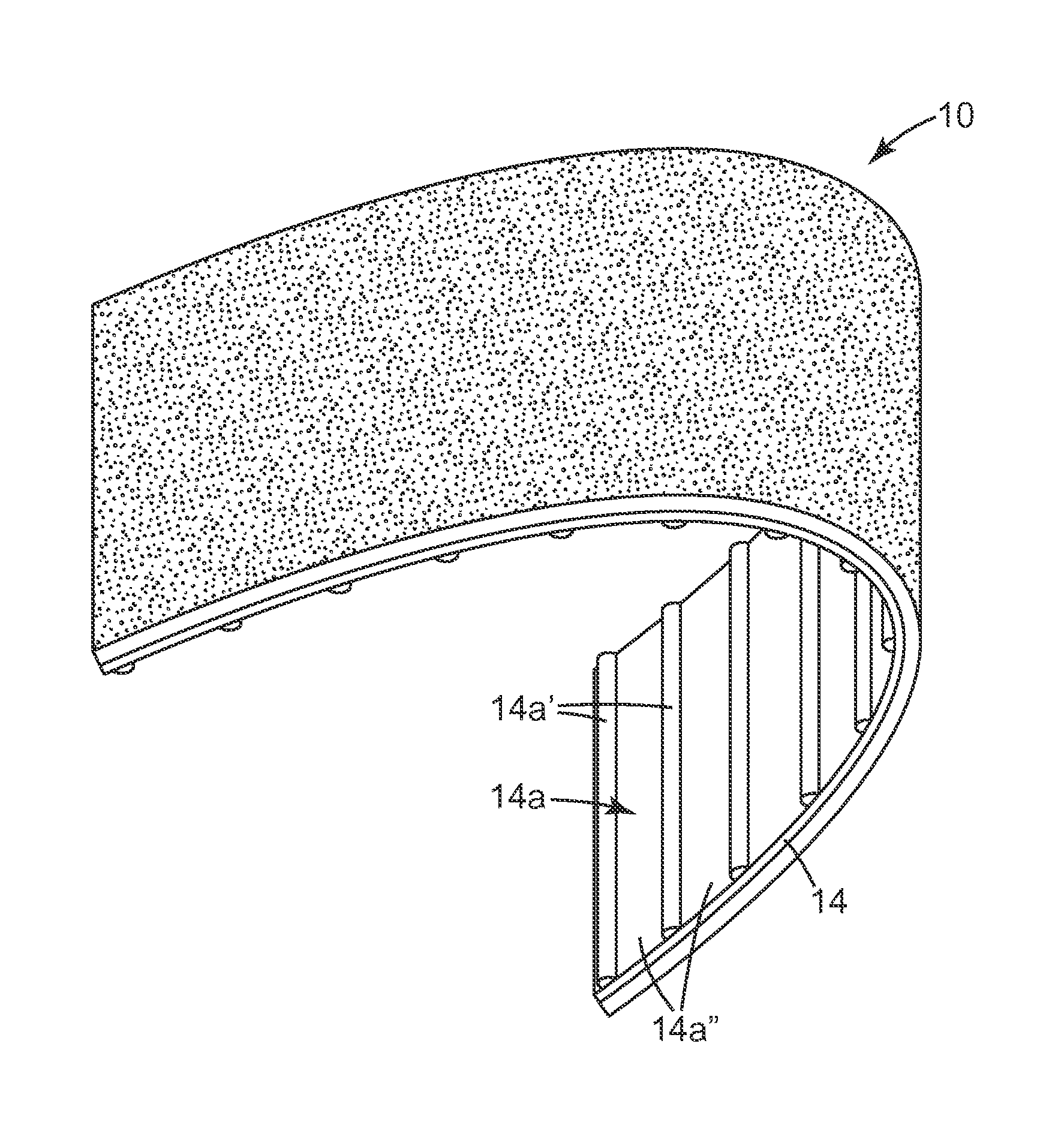Sandpaper with non-slip coating layer and method of using
a technology of non-slip coating and sandpaper, which is applied in the field of sandpaper with non-slip coating layer and method of use, can solve the problems of difficult to grasp, hold, and maneuver conventional sandpaper, difficult to grasp, and achieve the effects of improving durability, improving flexibility, and being easy to use and comfortable to us
- Summary
- Abstract
- Description
- Claims
- Application Information
AI Technical Summary
Benefits of technology
Problems solved by technology
Method used
Image
Examples
examples
[0080]In each of the Examples set forth below, commercially available sandpaper sold by 3M Company, St. Paul, Minn., under the product designation “216U P150 Production RN Paper A Weight, Open Coat, Fre-Cut” was used to make an abrasive article 10 having the construction shown in FIG. 1. 216U sandpaper is a general purpose sandpaper having an A-weight paper backing, a phenolic resin coated on one side, and aluminum oxide abrasive particles at least partially embedded in the phenolic resin. The second side (i.e. the non-abrasive side opposite the abrasive surface) of the sandpaper was then coated with one of the non-slip coating layers described below.
[0081]For each of Examples 1-8, the resulting non-slip coating layer 14 had a low level of tack that allowed the non-slip coating layer 14 to be folded over onto itself, and allowed the contacting surfaces to be readily separated without damaging either of the non-slip coating layer 14 surfaces, and without damaging or separating from t...
example 1
[0085]Example 1 was 216U sandpaper wherein the second side was coated with a blend of 90% by weight Kraton D-1161K SIS block copolymer sold by Kraton Polymers, LLC of Houston, Tex., and 10% by weight Wingtack Plus tackifier sold by Sartomer Company Inc. of Exton, Pa., dissolved in toluene, such that the resulting solution was about 40% by weight solids. The blend was coated onto the backing layer 12 to a thickness of 1.5 mils using a knife coater, and was allowed to dry at ambient conditions to allow the toluene to completely evaporate. The average coefficient of friction for Example 1 was not measured and is, therefore, not included in Table 1.
example 2
[0086]Example 2 was 216U sandpaper wherein the second side was coated with an acrylic hot melt adhesive produced by first partially polymerizing a liquid monomer mixture in an ethylene-vinyl acetate (EVA) pouch by exposing it to UV light. The liquid monomer mixture included 14% by weight 2-ethyl hexyl acrylate, 42% by weight butyl acrylate, 44% by weight methyl acrylate, and further included the following additives (in parts per hundred additives—ppha): 0.17 ppha Irgacure 651 photo-initiator sold by Ciba-Geigy Corporation of Hawthorne, N.Y., 0.06 ppha isooctyl thioglycolate, 0.004 ppha hexanediol diacrylate, 0.092 ppha alphabenzophenone, and 0.4 ppha Irganox 1076 antioxidant sold by Ciba Specialty Chemicals Corporation of Tarrytown, N.Y. The partially polymerized monomer mixture was then blended with the EVA pouch using a twin screw extruder, such that the partially polymerized monomer mixture blend also included 4 ppha ethylene-vinyl acetate (EVA). The partially polymerized pressur...
PUM
| Property | Measurement | Unit |
|---|---|---|
| glass transition temperature | aaaaa | aaaaa |
| speed | aaaaa | aaaaa |
| thickness | aaaaa | aaaaa |
Abstract
Description
Claims
Application Information
 Login to View More
Login to View More - R&D
- Intellectual Property
- Life Sciences
- Materials
- Tech Scout
- Unparalleled Data Quality
- Higher Quality Content
- 60% Fewer Hallucinations
Browse by: Latest US Patents, China's latest patents, Technical Efficacy Thesaurus, Application Domain, Technology Topic, Popular Technical Reports.
© 2025 PatSnap. All rights reserved.Legal|Privacy policy|Modern Slavery Act Transparency Statement|Sitemap|About US| Contact US: help@patsnap.com


